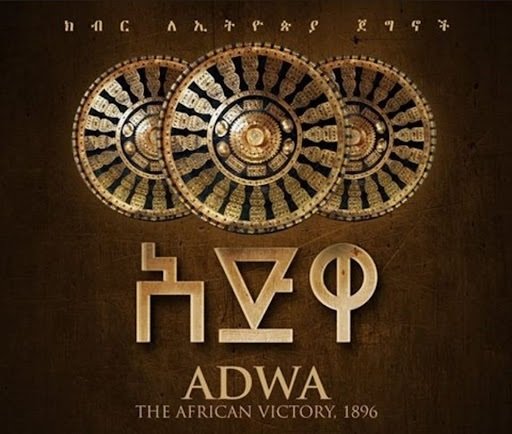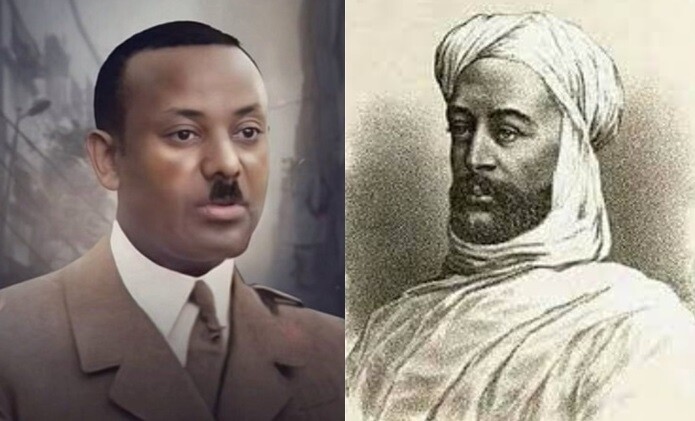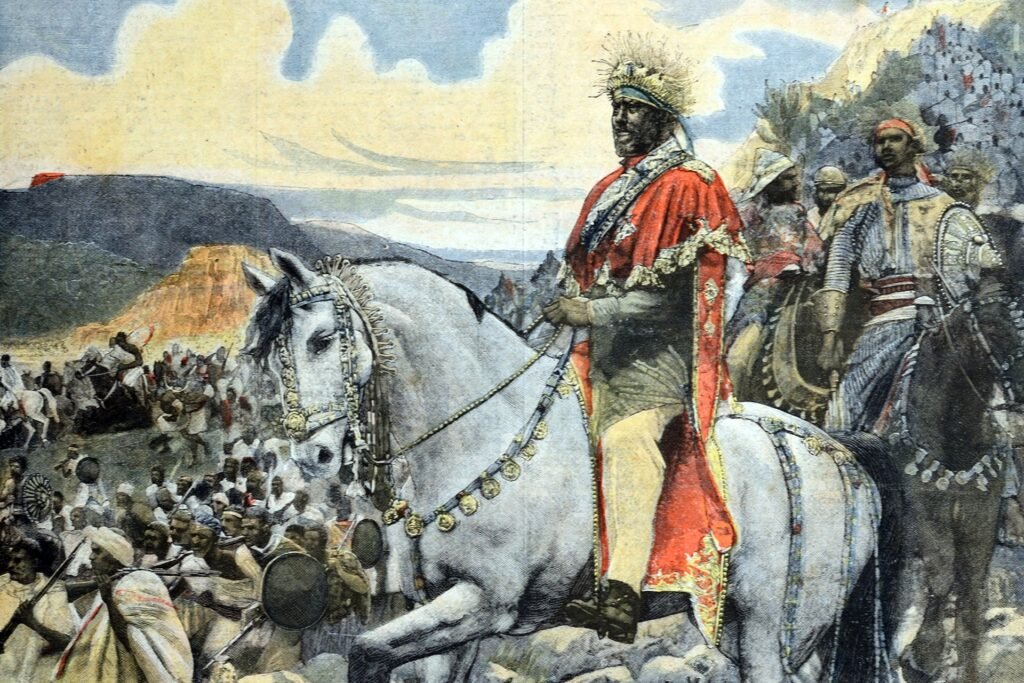Tsegaye Tegenu, PhD
2024-03-01

The battle of Adwa, a battle with significant national and international consequences, occupies a unique place in Ethiopian and African historiography. The troops which participated the battle were drawn from the various ethnic groups and constituted members of the military nobility, regional aristocracy, and peasantry. Farmers economy was the primary source for providing the logistic base of the battle. A large number of mules, horses and donkeys were raised both under the administration of the imperial court and at the local level. The system of provisioning was organized on the principle of self-sufficiency, with different sources. Thousands of sheep and cattle were brought to the campaign to be slaughtered for troop consumption.
In spite of communication and transport problems, in a matter of two months after the call for total mobilization on September 17, 1895, more than 100,000 soldiers were assembled in AddiS Ababa, Were IIlu, Ashenge, and Mekele. In Ethiopia, the theatre of military preparation was an aspect of the culture, and hence is not surprizing that a considerable number of resources efficiently was mobilized for the battle of Adwa. The preparation of the war in a limited period involved the whole country.
Emperor Menelik had to follow two strategic lines to achieve the stated military goal: first, the creation of a coalition of internal forces, and second, the organization and planning of the campaign. Prior to the engagement, Emperor Menelik had established the common objectives among the regional princes of northern Ethiopia and defined the conditions for their participation in the war. He resolved the problem he had with Ras Mengesha Yahannes; he also concluded agreement with the princes of Gojjam, Begemder, Wag, and Wello. The rases agreed to send their troops, to provide their gizat as supply areas, and to assist in any way needed. He was thus able to line up the troops of the princes, which amounted about one-third of the mobilized forces. Even at the last days of the war, Ras Sibhat and Dejjazmach Hagos who formerly allied with the Italian forces came back to the Ethiopian side and attacked the Italian column behind the rear.
The coalition of the rases resulted in a common plan of actions and the creation of a single command led by the Emperor himself and his delegates. The Italian military leadership counted on exploiting the internal conflicts. It envisaged rebellion or the neutrality of the regional princes, but this was a major mistake.
Strategically, Emperor Menelik succeeded in establishing an efficient and skillful organization and in planning the campaign. Indeed, the Ethiopian military leaders and troops had the established long tradition of mastering the high art of mobilization under difficult conditions.
The march to Adwa was relatively a long one, taking almost 5 months. The ground covered at a given day depended on the nature of the road. In the final phase, the rate of advance was dictated more by security concern and the need for supplies. In most are, as the road was covered with forest and heavy stones, the troops were forced to march divided. In some areas, such as the designated route to May Weyni, the road was so narrow and precipitous that troops had to cross one river twenty-eight times.
The long march was orderly. Since it was possible to encounter the enemy en route, march formation included forward detachment (to achieve security in the front and serve as covering force), the main body, and the logistic unit. The march formation was organized with regard to a rapid deployment of forces into combat formation. The plan for the march was prepared by the high military leadership consisting of the rases and order was given by or with consent of the Emperor. A coherent campaign plan was prepared based on the strategic objectives of the engagement, the examination of coalition of the internal forces, the degree of mobilization, the long distance of the march, and the goals and position of the enemy. Space will not allow to discuss the details on each of the orders, directives, directions and instruction given by the Emperor and the higher command of the rases to control the movement of troops and their execution in combat action.
The plan had envisaged the various courses open to the enemy and considered guarding boarders, opening another front at Awsa, and giving emphasis on strategic reserves of the armed forces. The plan evaluated the chances of success and predicted both the enemy’s probable responses and the main changes which could occur in such cases.
The campaign plan, adopted by the Emperor and the rases, was not actually an operational plan. Control of troop movements and actual conducting of engagements in war were left to the initiation of the rases. They did so following the course of action determined by the Emperor and the council of the rases.
The Ethiopian campaign plan dealt with measures taken in the mobilization and movement of troops far deep into the enemy territory by passing a small detachment force posted as defense. The military action of the Ethiopian armed forces was basically a strategic offensive accomplished through the opening of two fronts to defeat the main groupings of enemy troops deep into its own territory.
The battle of Adwa can be called a meeting engagement, which is a type of offensive combat. It was a clash of troops of the two sides advancing toward each other. From the outset, both sides attempted to carry out the assigned missions by means of a strategic offensive. The Italians defeated and chased out the forces of Ras Mengesha and took important areas in the region of Tigray to defend their stronghold in Eritrea. The Ethiopian forces conducted a long march north to penetrate deep into the enemy zone and engage its main force. At Adwa there was a rapid closing in of the two sides. Italy took the initiative and made a surprise attack through the rapid commitment of its main forces, attacking the center and the flanks of the Ethiopian army, to give it a sudden blow. But Italy could not sustain the initiative.
The Italians had an operational plan with a detailed combat action. It was drawn up by Baratieri, the Italian commander jointly with his senior commanders. The operational plan elaborated the performance of each unit, their mission, their position, the direction of their main attack, and their mutual support. This operational plan failed to conceptualize (i.e., grouping) of the Ethiopian forces. In the Ethiopian strategic culture, the conducting of engagement was left to the freedom of the commander and the initiative of the soldiers. Even if the Ethiopian troops were not in a combat form, the laying out of campaign and the position of the troops was in such a structure that made combat formation of troops very rapid. The Ethiopian way of military camping had an in-built defense mechanism and flexibility for the maneuver of troops to counter attack.
In combat action, camp commanders were expected to maneuver the troops in positions of left, right, center and rear as indicated by the strategic functions of the title. The maneuver is often accomplished by a close envelopment of the enemy flanks. Though the Ethiopian army was surprised, it was not difficult to search for a favorable position with respect to the enemy and to advance and make regrouping if the need arose.
The very structural formation of troops was flexible enough for the rapid maneuvering of troops in a moon-like shape, the essence of which was attacking the outer flanks of the enemy while concentrating superior force in the middle for a subsequent annihilation.
It seemed that Baratieri’s plan did not focus in the response of the structural formation and combat initiative of the Ethiopian troops. It mainly emphasized the method of employing weapons (effective use of his firepower), following the European style of warfare. In the Italian style of warfare, reliance was on firepower. Improvements in firearms (lighter and rapid firing guns, for instance) and changing battle tactics (line formation, and shoulder-to-shoulder drill for volley technics) were designed to increase and to ensure effective and maximum firepower; however, weapons were only effective when employed in a strictly disciplined way.
In the Ethiopian context, there was no tradition of reliance on fire power. Until the second half of the nineteenth century, firearms played a limited role in battles. Their numbers were limited and their qualities were relatively poor as most of them belonged to earlier periods. Therefore, there was no dependence on the effective use of fire arms; thus, no linear battle formation and no need for drill. The Ethiopian style stressed more on mobility and maneuver than on linear formation and on rank co-ordination. It was designed for short and decisive battle than for siege warfare. There was reliance on mass maneuver and a fast-moving confrontation involving cavalry and infantry forces. Battlefield tactics depended much on identifying the weakest links of the enemy. Actions were not characterized by battle formations rather they were dominated by individual initiatives, mobility and energy. Leadership and morale were ingredients important for success.
The Italian force lost the battle of Adwa not because of a tactical error, though chances playa great role in the outcome of a battle. The main reason was that in many ways they did not know the enemy they were confronting. Based on the general and strategic goal of the war and considering the budget constraints of the Italian government, Barateir’s preparation for the war and its planning was optimal. However, from the outset, they had no good knowledge of the response capability of the Ethiopian army, the military thinking of its commanders and the operational culture. During their preparation for the war, they counted on exploiting the internal conflicts between the princes, and, they encouraged internal rebellion and/or neutrality. They failed to see that the Ethiopian aristocracy had by this time built a system in which all could benefit.

















I had said the following celebrating the victory at Adwa many years ago and it still sits with/in me.
Hello Dear Countrymen!!!!
You know me by now that I have nothing but love for you. I am here to let you hear from me something that is very special for me both as your dear countryman but also as a man of color. That story and the day I am sharing with you is that glorious day etched in stone never to be concealed or left forgotten. It is that day that sends megawatt volts of pride all over my high mileage body every time I think or read about it. It is that glorious day, that day my and your grandparents marched into the hills, ravines and fields of Adwa knowing that it would be their last day on this good earth. They did that because no one had to tell them that it was their Allah given rights to defend their Allah bestowed domiciles from murderous bigots. No one had to tell them that heavily armed ‘KKK thugs’ were there to shoot and hang every ‘nigger’ in sight. They were in complete understanding that the enemy they were facing at that place on that day behooves them to be calculating and also well prepared. They understood very well that a vast network of intelligence must be in place to play that heathen on their doorstep. And they played him very, very well. It was written that the mad as hell patriotic chief from Tigrai was sending ‘secret’ messages to Baratieri his intention to defect to his side and he was waiting for the Italian chief to fire the first shot. It was also written about the ‘secret’ messages the emperor’s cousin Mekonen along with chiefs Haimanot and Mika-il(Ali) were urging him to come and kill their common enemy, the emperor. It was written that they were ‘telling’ Baratieri that the emperor army is getting thinner and fewer by the day that he was thinking about cutting and run for his life. They pondered!!! They lured!!! They lured and lured the monster from Rome until he was well inside their compound. When their single and double envelopment war plan is firmly on the ground they lured him again to fire the first shot. Dabormida might have sent a message to his wife that the very next day he would shoot a photo of him surrounded and being served by 3,000 ‘niggers’. What he did not know was the fact my Barentu ‘grand uncle’ and his Amhara, Tigrai and many other ethnic groups were watching his every move and primed to show him and his partners-in-crime how lethal an Ethiopian could be when his pride is touched by outsiders and ready to teach him a lesson or two how to conduct a conventional warfare Alula style, Mekonnen style, Taytu style, Haimanot style, Mika-il(Ali) style, Balcha style, Dinagde style leaving him no counteroffensive option! None! None except for Baratieri to cut and run like a scared witless rabbit or rather like a high noon bank robber chased by blood smelling vigilante mob!!!! But for my niggaz information or rather misinformation was part of the game. You think that misinformation was started by KGB and CIA during the cold war. No!!! It was my and your grandparent who perfected and used from the bottom of the deck to their advantage. They painted themselves as if they were deserted, far and few when their rank was swelling by the day!!! They presented themselves as people who love to run naked or have naked and did not have any clue what warfare is or how it was supposed to be conducted as an organized army. They even sent him fattened cattle, honey and milk to make him think they were still like his Neanderthals ancestors who were incapable of distinguishing friends from enemies. By now the Baratieri’s ego was so built up and emboldened by the news of potential desertion at the outset of war ordered the commencement of the battle. But his worst nightmare was awaiting him. His worst nightmare, a nigga with a Hotchkiss gun on his lap was all around him even before finishing his recital to the Roman gods. He could hear that thunderous scream of that fire spitting woman named Taytu admonishing those soldiers of the fainted hearts who tried to withdraw prematurely from the battle fronts!!!! He could hear her telling them that she did not bring enough skirt for them to wear!!!! And he could hear them telling that roaring Taytu like ‘Don’t talk to me like that, woman! I am going back!’ Baratieri saw those incensed men turning into killing machines, their fainted hearts gone in a flash!!! Now the earth and sky were laminated all around him with little leeway for folding back or escape. Now my Barentu grand cousin and his comrades in arms started playing the complicated mancala game in the middle of the battle. On one of their moves their led the arrogant Dabormida and his entire battalion plus army right into the welcoming arms of my Barentu grand cousins. When the carnage was over Dabormida was dying squealing like untidy pig. Now arch angels Jibril and Mika-il were in the mix. They were in the mix because that land of Maryam Magdalene and Bilal ibn Rabah was being desecrated by ruffians. They were in the mix because that land and its people were put together there by Allah at the beginning of times no matter the numerous and unabating travesties they had to go through. It is because it was the land where the two major religions, Christianity and Islam, had taken foothold there without the need of an all out battle. The battle Baratieri started on that day did not even last the entire length of the daylight. For intents and purposes it was over by the mid day. At 12 high noon, it was over. Now Baratieri turned around and ran like a scared deer from the Chercher Mountains!!! One of my grand cousins along with his Tigrayan and Amhara friends were in hot pursuit after him. But his horse was still fresh and not like their battle fatigued ones. But they stood on top of one the hills and told him who he really was. Oh Boy!!!! They were telling him using all kinds of words in their profane dictionary. No, I am not telling you what they yelled at him. No, no this is a family show. But I can tell you one so mildly. All three of them thundered at him like ‘You, the son of a thousand biscuits!!!!’ It seems he heard it all slammed into his bigoted ears carried by the drifting wind. How do I know that? You may ask. That is because I was teleported to that day!!!! I saw that thunderous lady Taytu telling off the retreating soldiers!!! You should all read more about her. Now some of you misogynistic pigs may doubt her role just because she was a woman. I highly suggest that you don’t say that around Lia bin Tadesse, Alemtsehay bint Wodajo, Birtukan bint Mideksa, Meaza bint Ashenafe, Muferiat bint Kamil, Aisha bint Mohammed bin Mussa and others in their posse who have been giving chauvinists like you that deadly stare of death. For now this high mileage, beyond-repair Afro-Ethio-centric nigga has been having a serious bout of an attitude since yesterday!!!!!